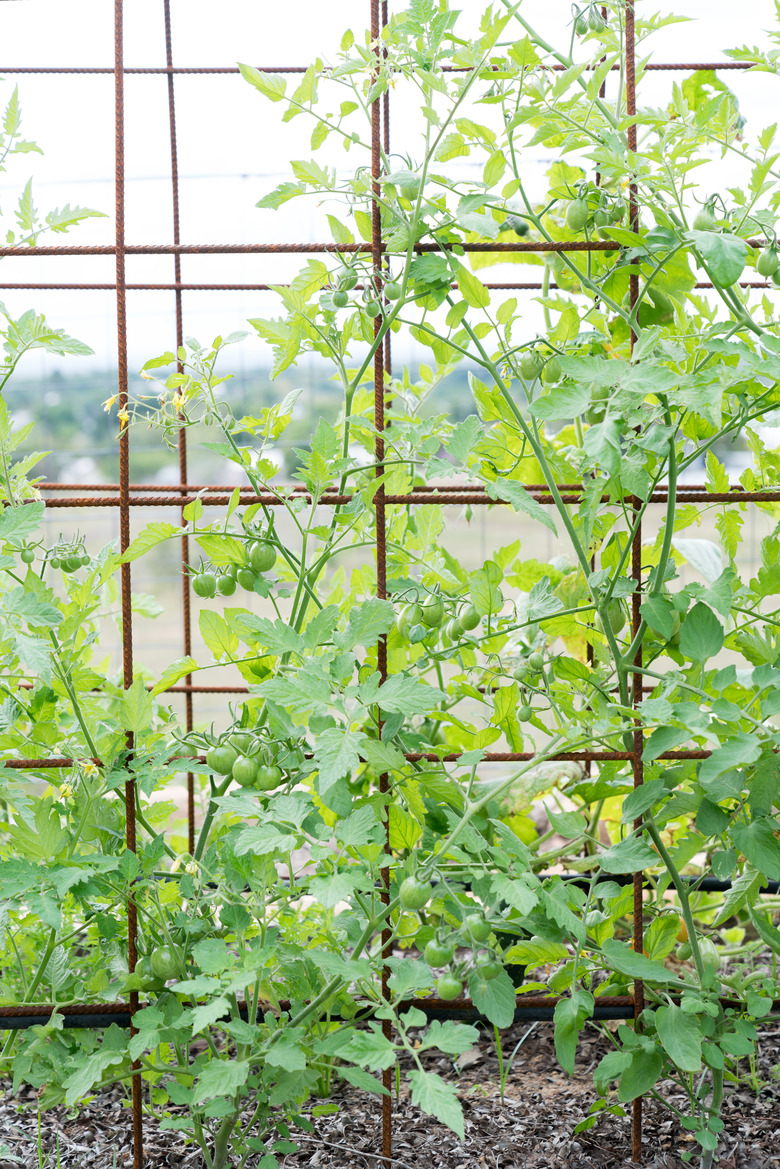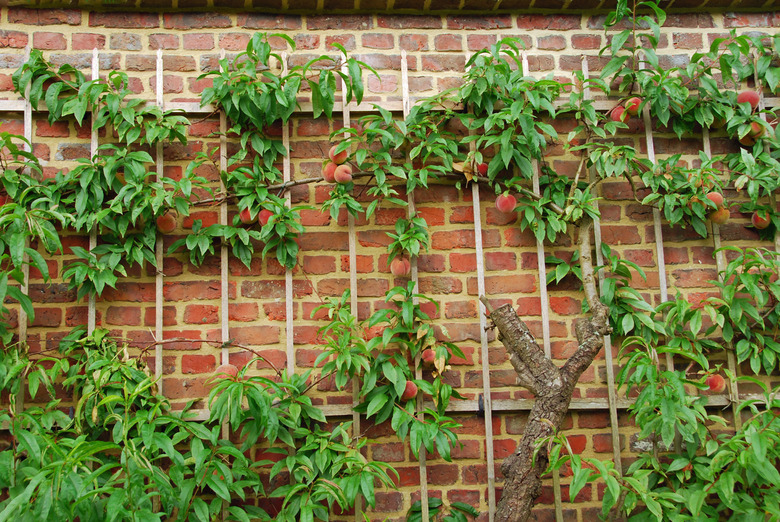How To Build An Easy And Inexpensive DIY Garden Trellis For Climbing Plants
We may receive a commission on purchases made from links.
A garden trellis is basically a vertical framework used to support climbing plants (like veggies, flowering vines and other greenery), and it can be as simple as wires strung between a simple, freestanding wooden frame or as sophisticated as a large, permanent cedar or redwood screen ornamented with curved edges and decorative moldings. A garden trellis can dress up a blank wall or frame an outdoor space that needs more definition.
When purchased at a store or constructed by a professional builder, a trellis can cost hundreds of dollars, but you can build an attractive DIY trellis that is quite simple using a couple of tools you probably already own and a small quantity of ordinary cedar lumber, readily available at home centers.
How you build your DIY garden trellis will depend on its purpose in your landscaping. In its classic use as a support for climbing plants, a trellis's in-fill — the patterned area between the outer frame — should be constructed with the intended plants in mind. Some vines, such as wisteria and climbing roses, produce very heavy stems and foliage, and a trellis for these plants must be built quite solidly to support a fair amount of weight. However, if you use your trellis simply to grow a vertical vegetable garden with seasonal pole beans or cucumbers, then very narrow vertical stiles or even just vertical wires are probably the only in-fill required.
Overview of the Trellis
Overview of the Trellis
This garden structure project will create a 4-foot-wide, 6-foot-tall simple trellis with inner grid squares that are about 1 foot across. It uses ordinary cedar 2x4 lumber for the legs, cedar railing balusters for the horizontal and vertical grid pieces and a single cedar 2x6 as a header across the top. The legs are an extra 2 feet long, designed to be buried in the ground to anchor the trellis in place, and the header is designed to overhang the trellis by 1 foot on each side. This overhang can be used to hang flower baskets, bird feeders or other ornaments if you choose.
You can easily adapt this design to other sizes of garden trellises by shortening or lengthening the legs or by changing the length of the horizontal grid pieces. You can also change the design to create a different in-fill pattern entirely. For example, to build a trellis to serve as a privacy screen for a deck or patio, you could use a lattice panels rather than 2x2 balusters for the in-fill portion of the trellis.
Lumber for Trellises
Lumber for Trellises
While any dimensional lumber can be used to make DIY trellises, it's best to use a wood that has good resistance to rot and insects. There are three standard options for this: pressure-treated pine, cedar or redwood. Pressure-treated pine is usually the longest-lasting choice and is often the cheapest choice, but it is not very attractive, though most home improvement centers now offer it in cedar tones. The unattractiveness may not be an issue for you if the trellis will always be covered with heavy vines, but if the trellis itself is used as a decorative item, then you'll want a higher-quality wood.
At the other end of the spectrum is redwood, a simply gorgeous wood that is very expensive and sometimes hard to find. You may not want to buy redwood out of concern for protecting redwood forests. There's no question about it, though — a redwood trellis is the top of the line.
The interim choice is the one that most people choose for outdoor projects: cedar. Like redwood, cedar has a natural resistance to decay and insect damage, but it is considerably less expensive. Cedar is also a fairly attractive wood, especially when you purchase "A" or "select" grades. Cedar is a widely available wood that is grown commercially, so there are no environmental concerns. It is relatively affordable, and it can last for decades, especially if it is periodically sealed.
Things Needed
-
(8) 2x4 cedar boards, 8 feet long
-
(6) cedar 2 x 2s, 8 feet long
-
2 1/2-inch and 3 1/2-inch deck screws
-
(1) cedar 2x6, 6 feet long
-
Wood sealer or stain (optional)
-
Concrete mix (optional)
-
Lag screws or angle brackets (optional)
-
Drill with driver bit
-
3/16-inch twist bit (optional)
-
Post-hole digger or shovel
-
Paintbrush (optional)
How to Build a Garden Trellis
1. Cut the Trellis Parts
Unless you purchased all the cedar parts already cut to size (some specialty lumber yards will do this), you will need to cut the cedar boards to the necessary length. You will need:
- Four cedar 2x4s as the leg pieces, each 8 feet long.
- Six horizontal grid pieces made from 2x2 cedar balusters, 4 feet long.
- Three vertical grid pieces, also made from 2x2 cedar, 6 feet long.
- If necessary, cut the 2 x 6 to a 6-foot length, which will serve as the header.
Any saw will work for this, but a power miter saw is the best for making fast cuts that are perfectly square.
2. Lay Out the Pieces
On a flat, hard surface (such as a driveway), position two 2x4 leg pieces exactly 4 feet apart with the tops perfectly aligned. Over these two parallel leg pieces, position the six horizontal 2x2 grid pieces across the legs, exactly perpendicular to them. The top grid piece should be positioned 1 foot down from the top of the leg pieces. The bottom grid piece should be positioned 2 feet up from the bottoms of the legs. Space the remaining four horizontal grid pieces at even intervals between the top and bottom pieces — about 1 foot apart.
It is very important that everything be square as you position the pieces. Use a framing square to make sure all angles are square.
3. Attach the Horizontal Rails
Use 2 1/2-inch deck screws and a drill with driver bit to attach each horizontal grid piece to the leg pieces. Use a single screw at each leg. If the cedar rails seem prone to splitting, you can drill pilot holes with a 3/16-inch twist bit before driving the screws.
Position the remaining two leg pieces over the ends of the grid pieces so they are carefully aligned with the bottom leg pieces. The grid pieces are now sandwiched between the two leg pieces. Secure the top leg pieces with 3 1/2-inch deck screws driven down through the grid pieces and into the bottom of the leg "sandwich." You now have the basic frame of the trellis.
4. Attach the Header
Position the 2x6 header flat over the top ends of the legs so it overhangs by 1 foot on each side. Align one edge of the header so it is flush with the legs on the back of the trellis; the front edge of the header will overhang the legs on the front side by about 1 inch. Secure the header to the leg pairs with 3 1/2-inch deck screws driven through the top of the header and into the end grain of the leg pieces. Make sure the header gets secured to each of the four leg pieces.
5. Attach Vertical Grid Pieces
Next, position the three 6-foot-long vertical grid pieces across the horizontal pieces so the top ends butts up against the header. Measure carefully to make sure the vertical pieces are evenly spaced and are square to the rails. Attach the vertical pieces to each of the horizontal grid pieces with 2 1/2-inch deck screws.
6. Get Creative (Optional)
If you wish, you can dress up your new trellis by adding additional elements. For example, you can create diamond shapes within the grid by cutting and attaching diagonal pieces between the horizontal and vertical pieces. If you want a more solid screen, you can add more vertical pieces, reducing the size of the grid.
You can shape the ends of the overhanging header by rounding them off, or you can attach finials or post caps to the ends of the header. You can also attach eye hooks to the ends of the header to support hanging flower baskets.
Wood trim pieces could be used to cover the joints where the leg pieces meet the rails. There is really no end to the creativity you can bring to making your own trellis.
7. Finish the Trellis (Optional)
Cedar lumber will age to an attractive weathered gray if you simply allow it to remain exposed to the elements. If you prefer to keep it looking new, you can brush on a weatherproofing sealer or stain it to a different tone.
Follow the manufacturer's recommendations on this; some may suggest that you allow cedar to age for a few months before sealing it.
8. Mount the Trellis
To mount your trellis, dig post holes 2 feet deep and then insert the trellis legs into these holes. Adjust it for level and plumb and pack soil around the legs. In most instances, this will be enough to solidly anchor your trellis in the ground. If you want a truly permanent structure, you can fill these holes with concrete to make solid footings.
Note that if you are attaching the trellis to another structure, such as a house wall or a fence, you can alter the design when building it to include shorter legs. Then, attach the trellis to the structure with lag screws or angle brackets.
Growing Plants on Your Trellis
Growing Plants on Your Trellis
There are many annual and perennial vines that can be grown on a trellis, but remember that each plant has its own cultural needs, and vining plants vary in their method of climbing, which can affect your choice of plants:
- Tendril-producing plants have thin, antenna-like shoots that whip about until they find a support and then quickly wrap around it. Some examples of tendril plants include grapes, passionflowers, clematis and sweet peas. A trellis with relatively small in-fill grid spaces works best for this type of plant. With this project, running some thin, invisible wires through the grids might help tendril plants climb faster.
- Twining plants find a way to climb almost any vertical structure. Wisteria, honeysuckle and chocolate vine fall into this category. With this kind of vine, you don't have to do much of anything except plant it and wait. The entire stem grows in a corkscrew fashion to wind its way up any vertical support it finds. This kind of plant can be very strong and heavy, and your trellis will need to be very strongly built.
- Aerial roots are used by some plants to climb. English ivy is an example of this. The tiny roots find a way to grab onto almost any rough surface. This type of plant is not a good choice for a trellis, as it will simply continue growing and quickly overwhelm the trellis on its march onward.
- Suckering discs are found on some plants. Virginia creeper, for example, has tendrils that end in little suckering discs that stick to whatever they touch. The suckering parts can badly discolor and even damage a surface, so be careful where you plant these vines. On other types, thorns serve as grappling hooks to hold the stems in place on the trellis.
- Ramblers are not true climbers since they don't have genuine mechanisms for grabbing onto supports. These plants have very long stems that must be manually attached to the support structure. So-called climbing roses fall into this category — they don't climb so much as ramble. All climbing roses will need to have their canes manually secured to the trellis. Climbing roses and other ramblers are ideal choices for the trellis design featured in this project.


